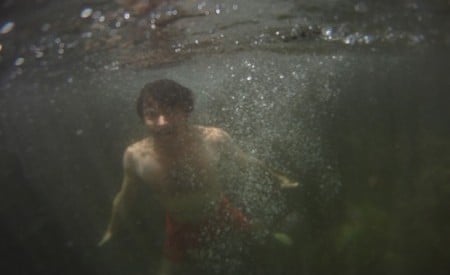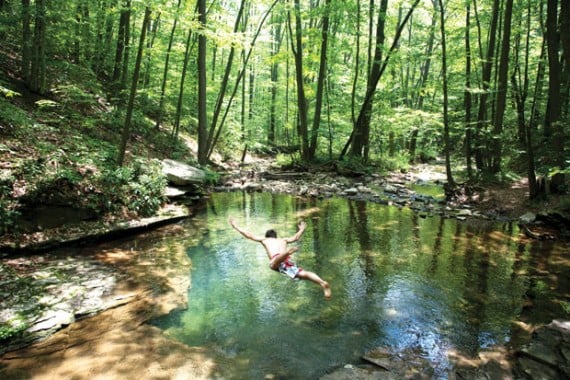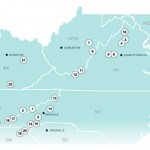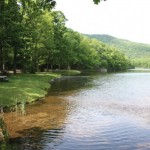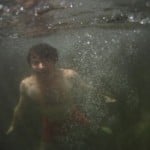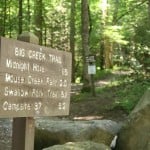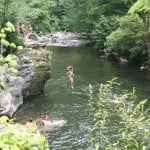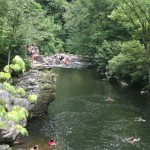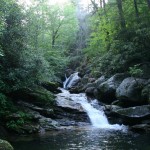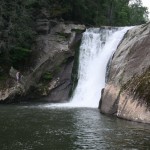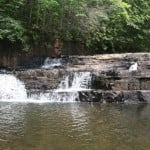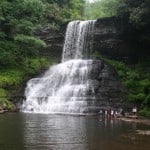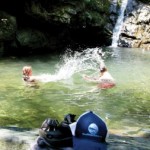Swimmers splash in the Cedar Run Pool below the falls, a three-tiered waterslide in Shenandoah National Park.
Open to the public: Swimming holes on public land.
Late summer in the South means heat you can see, humidity that feels like breathing through a straw, and air so stale you have to push it out of the way. The only way to escape the oppression is to either stand in front of the fridge with the door open or head down to your local swimming hole and take a refreshing dip in nature’s air conditioner. Don’t have a mountain creek running through your apartment? Don’t worry, we’ve got you covered with some of the best swimming holes open to the public all summer long.
NATIONAL PARKS
GREAT SMOKY MOUNTAINS NATIONAL PARK
Great Smoky Mountains National Park is America’s most visited national park, and it’s not hard to see why once you venture inside its borders. Rugged mountains, diverse wildlife, and more mountain streams than you can shake a stick, or fishing pole, at. Because of the sharp terrain, most of these creeks and streams tumble over rock slides and waterfalls at some point in their travels, creating deep pools filled with water as cold as the air is hot. The age-old battle of water versus rock and earth has culminated in a swimming hole paradise.
1. Midnight Hole
In the far northeast portion of GSMNP, Big Creek flows out of the Balsam Mountain region and into Tennessee via the Pigeon River. This is one of the least crowded spots in the park, and Midnight Hole is worthy of the short hike. Two rivulets flow into a deep emerald pool perfect for dropping into from the rocks above.
Difficulty—Moderate. A gradual 1.5-mile hike up a rough gravel road will put you at Midnight Hole. A half mile more puts you at equally impressive, but not as swimmable, Mouse Creek Falls, a nice spur hike to get the blood flowing if you arrive before the sun is high in the sky.
GET THERE—Take exit 451 off of Rt 40 near the Tennessee/North Carolina state line. Cross the Pigeon River and bear left following this road into the Big Creek area of the park. Follow the road until you reach a picnic and campground area. The trail will be before the parking on the right side.
2. The Sinks
Remember when you were a baby and you took your baths in the sink? Of course you don’t, but if you did it would be something like this. Except colder, and momma isn’t giving you googly eyes and Cry No More baby shampoo treatments. A series of cascades flows under Little River Road in the north central part of GSMNP providing ample opportunity to bathe in the clear water. Not much privacy here, and the hydraulics can be dangerous at times, so take the trail a short way downriver for more casual swimming.
Difficulty—Easy. If the water is low, head straight from the car to the river; if the water is high, take a short walk downstream.
GET THERE—Take 441 South out of Gatlinburg to Little River Road for 11 miles. Pull off just before the bridge into a small parking area. A trail leaves from the information sign downstream.
SHENANDOAH NATIONAL PARK
There are so many rivers and streams meandering through Shenandoah National Park in northwest Virginia, it would be nearly impossible to walk a mile without getting your feet wet. Follow the length of Skyline Drive and you can easily access falls and pools on either side of the road, the same swimming holes homesteaders were dipping their toes in 250 years ago. So get out your denim overalls and best homemade straw hat and jump in.
3. Cedar Run
Whiteoak Canyon gets a lot of press being the best area for swimming holes in SNP. The namesake falls draws a ton of visitors in the summer, but just down the trail is a series of pools known as Cedar Run. The three waterfalls that make up Cedar Run all feature their own unique attractions, from natural water slides to jumping rocks. If you are in the mood for a longer hike, link up the Whiteoak Canyon Trail for an 8-mile burner.
Difficulty—Moderate.
GET THERE—There are several ways to get to Cedar Run. The first is to hike down the Cedar Run Trail from the Hawksbill Gap parking area between mileposts 45 and 46 of Skyline Drive. Alternately, you can hike up the same trail from the Whiteoak Canyon parking area off Rt. 600. Both are around a three mile hike, but with some elevation change so be prepared for some steep sections.
4. Big Rock Falls
This quant little waterfall does not get a lot of attention because it usually gets bypassed by visitors on their way to Rapidan Camp, also known as Hoover Camp. This is where the President and his wife came to retreat and wet a line for trout in the Rapidan River. Big Rock Falls is a slight misnomer in that there are not a huge number of boulders on the small stream, but the water does flow over a large rock formation creating a natural slide into the cool waters below.
Difficulty—Easy.
GET THERE—Park at the Milam parking lot just short of MP 53 on Skyline Drive. Follow the A.T. for a 100 yards then turn onto the Mill Prong Trail. Follow this trail until it crosses Mill Prong a second time. It’s a three-mile round trip.
BLUE RIDGE PARKWAY NATIONAL PARK
The ribbon of national park that is the Blue Ridge Parkway runs through the best landscape the Southeast has to offer. No road trip would be complete without a quick stop to take a dip in one of the numerous swimming holes easily accessed from the parkway. Just hang the suits out the window to dry.
5. Skinny Dip Falls
Despite its name, Skinny Dip Falls is not a nudist sanctuary. You would probably be treated with a fair amount of hostility if you chose to go au naturale at this beautiful waterfall. Easy access and a stunning setting make this a must-do if passing through on the Parkway.
Difficulty—Easy.
GET THERE—The short half-mile trail to the falls is directly across the Blue Ridge Parkway from the Looking Glass Overlook at milepost 417. Drink in the views of Looking Glass Rock before heading down to the falls.
6. Sherando Lake
If you are on the Blue Ridge Parkway, chances are you are on a road trip, or at least you should be. Stopping on the side of the road for a picnic is great, but so is spending a three-martini lunch at a great lakeside recreation area like Sherando Lake. Facilities like tables, bathrooms, and roped off swimming areas will make you feel like you have stumbled onto some sort of backwoods country club—and you wouldn’t be far off.
Difficulty—Easy.
GET THERE—Take VA Rt. 814 off the Blue Ridge Parkway at milepost 16. Follow the road 4.5 miles to the entrance to Sherando Lake.
Swimming Safety
Taking a hike to a swimming hole can be a relaxing and refreshing way to spend the afternoon, but can take a dangerous turn if things go awry. Stay safe by following a few simple rules when taking a dip.
THE BUDDY SYSTEM
This is an oldie but a goodie: never go swimming alone.
CHECK THE CURRENT
Rivers that seem calm on the surface can be roiling below, so wade in gradually to avoid getting swept away.
DEPTH CHARGE
The water cascading over a falls can be beautiful, but can also be deadly. Hydraulics below falling water can trap you under, or rocks could pour over the top of the falls and come raining down. Make sure you are aware when wading around.
LOOK BEFORE YOU LEAP
Always check the depth of a hole before jumping in. Even if it appears deep enough, hidden rocks or other debris could put a serious damper on your adventure.
BAREFOOT AND BOOZY
These go together like peas in a pod. Don’t drink and dive and don’t go barefoot around places people have been drinking. Glass is sharp.
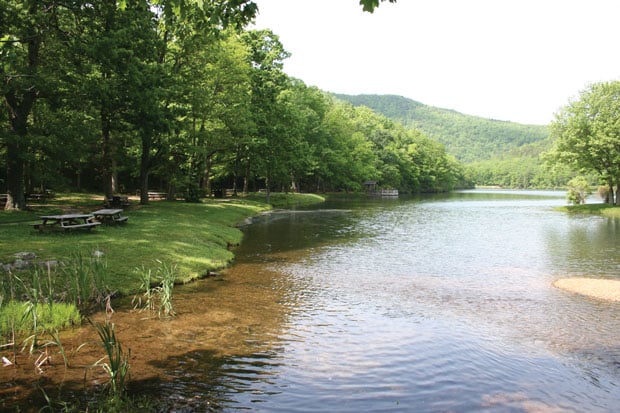
NATIONAL FORESTS
MONONGAHELA NATIONAL FOREST
The wildest stretches in Wild West Virginia reside inside Monongahela National Forest, which contains one of the most diverse ecosystems in the East. High vistas, low valleys, and lush greenery make this national forest a hiker’s playground. Miles of country roads provide the access; all you need to do is bring your denim cutoffs.
7. Whitaker Falls
Whitaker Falls on the Elk River lies just outside the national forest boundary, but it is such a good swimming hole, we’ll include it here. This hole has everything one could need: deep, clean water, huge expanses of rock for sunning and ledges for sending it into the water below. You can even swim behind the falls or take a ride on the rockslide just upriver. A classic if there ever was one.
Difficulty—Easy.
GET THERE—Whitaker Falls is visible from the road so finding it is not a problem. Take Valley Fork Rd west from Rt. 15 at the park boundary. Follow Valley Fork 6.7 miles until you see the falls.
8. Knapp Creek
There are several spots to splash around on Knapp Creek, and locals have been cooling down here for generations so you know it’s good. Local touches include an old diving board and ladder bolted to a large boulder.
Difficulty—Easy.
GET THERE—Take Rt 39 east out of Marlington into Monongahela. Pull off just before you hit the intersection with Rt. 28. Hole is visible from the road.
GEORGE WASHINGTON NATIONAL FOREST
The GWNF not only contains amazing natural wonders, but also the remnants of the former coal industry that used to dot the landscape. The coal miners came to the area for the same reason swimmers do today, an abundance of mountain streams to turn their cranks.
9. St. Mary’s Falls
St. Mary’s Falls lies deep in the heart of St. Mary’s Wilderness located in the northern section of the national forest. The falls themselves are a gorgeous multi-tiered cascades with plenty of depth for leaping off the 10-foot high rock ledges that line the pool. The hike in can be a bear, but that just makes the dip all that much more refreshing at the end.
Difficulty—Hard.
GET THERE—The old access road appears to be washed out so take the gravel road off the Blue Ridge Parkway at mile marker 23. Take the Mine Bank Creek Trail for two miles until it reaches the junction with the St. Mary’s River Trail and turn left. Another 2-mile hike will put you at the falls.
10. Red Hole
This swimming hole is located at the most northern tip of the GWNF, just south of I-66, which makes it easily reachable from the swelter of the city – Washington, D.C. that is. This piece of water is alternately known as Buzzard Rock Hole and, although neither of these monikers is particularly appetizing, this swimming hole is primo. A huge flat rock slanting into the creek provides ample space for sitting and sunning and the gentle rapids and deep pool are ideal for a family outing.
Difficulty—Easy.
GET THERE—From Rt. 55 take Fort Valley Road 2.5 miles south along Passage Creek. Park in the second paved lot and follow the creek north for a quarter mile where you will see the slanting rock diving into the creek.
JEFFERSON NATIONAL FOREST
The southern twin of the George Washington and Jefferson National Forest covers huge swaths of southwest Virginia, meaning it covers huge swaths of awesome mountain landscape. The Bermuda Triangle formed by I-81, I-64, and I-77 holds two of the best swimming holes in Virginia.
11. Cascade Falls
Be prepared to break a sweat when heading to this 60-foot waterfall: a mandatory 2-mile uphill hike is required to reach it. The juice is worth the squeeze however as this is one of the most beautiful falls in the state. Little Stony Creek pours over the rocks into a deep, cold pool surrounded by soaring 200-foot rock walls.
Difficulty—Moderate.
GET THERE—Take exit 118 off I-81 and follow Highway 460 for 26.6 miles to Cascade Drive. Follow the signs for Cascade Falls Recreation Area.
12. Falls of Dismal
No need for doom and gloom when visiting this cascading falls. Dismal Creek flows over a rock structure resembling the great staircase of a southern estate creating the perfect environment for sitting or jumping into the pool at the base of the falls.
Difficulty—Easy
GET THERE—Take exit 98 off I-81 and follow Rt. 100 for 11 miles then turn left onto VA Rt. 42. After 10 miles turn right onto VA-606, then right again onto Dismal Creek Road. Follow this for a mile to a pull off on the right with a trail that leads down to the falls.
PISGAH NATIONAL FOREST
Pisgah is known for many things, mainly its raw outdoors swagger and epic mountain biking trails, but when it comes to swimming holes, this national forest is no slouch. From the backcountry to back behind the cabin, there are plenty of places to soak your tired muscles after getting off the trail.
13. Elk River Falls
Elk River Falls is one of the best swimming holes in Pisgah National Forest, with a high waterfall, deep pool, and plenty of rocky cliffs from which to leap. Flat rocks all around, a short access hike, and a generally scenic atmosphere only add to its reputation. It is no wonder Elk River Falls is one of the more popular destinations to cool off on a summer weekend. Beat the crowds by getting there early or hitting it on a weekday.
Difficulty—Easy. A 15-minute hike from the parking lot puts you at the top of the falls with only a short scramble down to the pool.
GET THERE—Take Elk River Rd. out of the tiny hamlet of Elk Park, N.C. for 4 miles where it ends in a trailhead. Parking may be sparse on a hot summer weekend.
14. Carolina Hemlock
Located at the Carolina Hemlock National Forest Campground, this section of the South Toe River has something for everyone. The water comes directly off Mount Mitchell making it extremely cold. Don’t worry, as there are plenty of flat rocks to lay out on after shocking your system by jumping off one of the surrounding rocks into the deep clear water. This is also a great spot for a short tube.
Difficulty—Easy.
GET THERE—From the Blue Ridge Parkway, follow Rt. 80 north 5.5 miles until you see signs for the campground.
NANTAHALA NATIONAL FOREST
Nantahala means “land of the noonday sun” in Cherokee, which may seem great until you realize this means the sun only hits the valley floor when directly overhead. Brrrr. But water abounds in the largest of North Carolina’s national forests, and a little shade never hurt anybody. Just don’t forget your towel.
15. Turtleback Falls
Turtleback Falls is part of a very popular string of falls and swimming holes along the Horsepasture River outside Brevard. These falls include the photogenic Rainbow Falls and Hidden Falls, both of which attract many visitors. Turtleback is just upriver from Rainbow and features a sliding rock, vast areas of open flat rock for lazing about, and jumping areas.
Difficulty—Moderate. About a two-mile hike from the parking area.
GET THERE—Head south on Rt. 64 out of Brevard for 18 miles then turn south on Rt. 281. Look for signs on the left for Gorges State Park and the trailhead.
16. Secret Falls
Consider it a secret no longer. This 60-foot falls has been off the radar for some time due to the difficulty of access, but the Forest Service recently put in a new trail that makes getting to this deep mountain pool much easier. Plus a shallow sandy area makes this a great place for the kiddos.
Difficulty—Moderate. One-mile round trip hike.
GET THERE—Take Horse Cove Road east out of Highlands, N.C., for 3.7 miles and turn right onto Walking Stick Road. After 3 miles, turn right onto Forest Road (FR) 4567 where you will eventually see a small parking area and a sign for Big Shoals Trail.
CHEROKEE NATIONAL FOREST
This national forest bookends Great Smoky Mountains National Park, so you know it’s good. In a region famous for its waterways, these swimming holes are your best bet.
17. Baby Falls
It may be called Baby Falls, but this ain’t no kiddie pool. Put on your big boy pants if you are planning on taking a leap from the top as this falls is part of the sometimes-raging Tellico River. Besides the 15-foot cascade and main pool, you can walk the river above the falls and find shallow places for lounging. Just watch your step lest you get swept over.
Difficulty—Easy
GET THERE—From Tellico Plains just outside the national forest boundary, take the Cherohala Skyway (Hwy 165) east into the national forest for about 5 miles. Bear right onto River Road (FR 210), which follows the river. You will see the falls from the road.
18. Conasauga Falls
Conasauga Falls is another spectacular cascading waterfall in the Tellico Ranger district of Cherokee National Forest. This multi-tiered drop features several small pools incorporated into the falls and has been run in a kayak at high water. Don’t be afraid to explore upriver and down for more swimming options.
Difficulty—Moderate
GET THERE—The trailhead for the 1.5-mile round trip hike can be found by taking Rt. 68 south out of Tellico Plains. After 2 miles, turn right onto Forest Service Road 341. Look for the large Forest Service sign and take the right fork to the trailhead.
CHATTAHOOCHEE NATIONAL FOREST
North Georgia’s Chattahoochee National Forest contains some 2,200 miles of rivers and streams, a virtual water lover’s paradise. Get off the beaten path with these two short swimming hole hikes.
19. Raven Cliff Falls
The Raven Cliff Falls Trail snakes along Dodd’s Creek in the southeastern section of Chattahoochee National Forest. The trail to the falls is a moderate 2.5-mile hike, but there are numerous swimming options along Dodd’s Creek if you don’t feel up for the whole trek. The falls themselves are lined by towering cliffs and appear to come right out of the rock face, creating a unique illusion.
Difficulty—Hard
GET THERE—From Helen, Ga., take Rt. 75 north for 1.5 miles, then take a left onto Rt. 75 Alt. Look for the Richard Russell Scenic Highway on the right after about 3 miles. The trailhead is clearly marked on the left.
20. Blue Hole Falls
Death, taxes, and a swimming hole named Blue Hole—those are the guarantees of life. This particular Blue Hole lies at the base of a 15-foot waterfall on High Shoals Creek and usually features enough depth for a leap from the rocks lining the pool. Dip a toe in before you jump however, because this water comes straight from the mountains and can be shockingly cold.
Difficulty—Moderate
GET THERE—Take Rt. 75/17 north out of Helen for 11 miles then take a right onto Indian Grave Gap Road. This is a gravel road, but is usually passable with a normal car. There is a well-marked trailhead for the two-mile round trip hike.
DANIEL BOONE NATIONAL FOREST
One can imagine the figure of Daniel Boone, great explorer and outdoorsman, emerging from the woods onto a pristine swimming hole and laying down his rifle for a dip. Maybe he climbed up that rock face and did a cannonball in sheepskin chaps, maybe it was a jackknife, but either way, I’ll bet he was refreshed afterwards.
21. The Rocks
The Rocks is a local’s favorite because of its deep water and plethora of (what else?) rocks to jump from. This area is located in the Red River Gorge region of the Daniel Boone National Forest, making for a very scenic swim with lots of other activities in the immediate vicinity. Several swimming holes are in this area so don’t be afraid to explore if this one is too crowded.
Difficulty—Easy
GET THERE—From Winchester take the Bert T. Combs Mountain Parkway east to exit 36. Take Rt. 11 north, then turn right onto Rt. 77, then right again onto Rt. 715 into the Red River Gorge. Ten miles down this road you will see the hole – look for the Mile Post 1 sign.
BONUS
*Dog Slaughter Falls
Don’t let the ominous name turn you off from one of the most scenic falls in Daniel Boone N.F. While some falls in the area dry up in peak summer, Dog Slaughter is guaranteed to be running year-round. Its wide curtain allows you to walk behind the falls and the whole area is surrounded by overhanging rock.
Difficulty—Moderate
GET THERE—Take I-25 west out of Corbin, Ky., to Rt. 90 entering Daniel Boone National Forest. Look for Forest Road 195 on your right and follow that for another three miles to a wide parking area. Follow Dog Slaughter Trail #414 on a three-mile round trip to the falls. •
Like Tarzan
One of the best features of a classic swimming hole is the presence of a good old-fashioned rope swing. Rope swings come in many different shapes and sizes, but the proper technique is essentially the same for each.
1. Grab the rope as high as you can with two hands. This will prevent you from ending up on YouTube as one of those losers who face plant in the dirt before reaching the water. If you don’t want to look like an amateur, this is the single most important step.
2. Take a rocker step. This does not mean playing air guitar in mid swing, but means taking a large rock back before lift off to maximize velocity. This is where the two hands really become essential.
3. Relax. When reaching the bottom of the swing arc—if you haven’t hit the ground and are currently being laughed off the lake—relax your arms so you are hanging loose; your arms, not your hands. This is also the moment to make sure the rope is not wrapped around your ankle, or anything else for that matter.
4. Sweet release. Once your pendulum swing has reached its maximum altitude, now is the time to let go for maximum height. If you are looking for maximum distance, release a little sooner and straighten out like an arrow. Do not, for any reason, continue to hold onto the rope and swing back toward your launch point. This will result in the loss of your friends and possibly consciousness.
Jorts
From Never-Nudes to rodeo cowboys to subway hipsters,denim has been protecting Americans, and the American way of life, for a long time. Although they have evolved over time to adapt many styles and functions, the key feature of jeans is still their durability. Nowhere is this more apparent then when sliding 20 feet down harsh stone on your butt, the rock’s roughness only thinly veiled with a thin layer of moss. This type of activity calls for cut-offs.
Yes, jean cutoffs have gotten a bad rap over the years, but this does not mean they are unimportant. Ditch the board shorts and the nylon for some denim and you will notice, and feel, the difference on that first slide. Also, when you drop your jeans at the swimming hole only to reveal your ‘swimmin jeans’ underneath, you are sure to instantly gain the respect of the locals.
Also, don’t forget to check out Jack’s Road Trip Guide as well!
